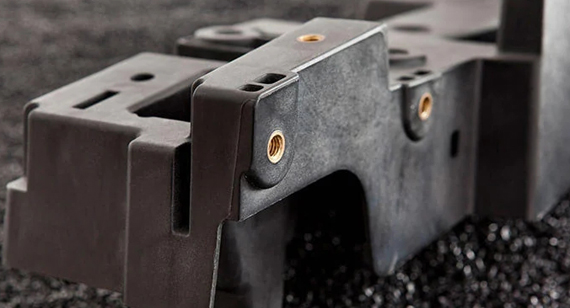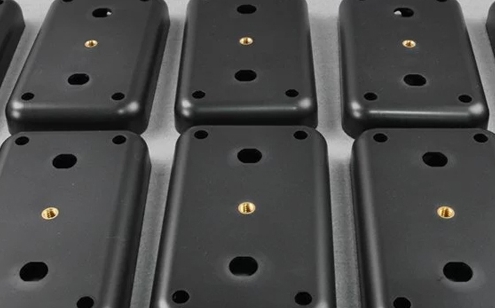What Is Insert Molding? Process, Types and Applications
Insert molding technology is a technology that embeds inserts made of metal, plastic or other materials into plastic or other base materials to form a composite structure. This technology plays an important role in the field of CNC machining, especially in improving product performance and reducing costs . This article will discuss the process flow, types and practical applications of insert molding in detail.
What is Insert Molding?
Insert molding is a plastic molding process that is usually used to accurately embed inserts of metal, ceramic or other high-strength, high-conductivity materials into plastic parts to enhance the structural strength, conductivity or heat resistance of plastic parts. This process has been widely used in many fields such as automobile manufacturing, electronic equipment production, consumer goods manufacturing, etc., providing strong support for the manufacture of high-quality, high-performance products.

Insert Molding Process
Insert molding is a specialized injection molding technology used to encapsulate pre-assembled components in a plastic housing. This process can enhance part functionality, improve structural integrity, and reduce post-assembly costs. The following are the insert molding process steps:
| Step | Description |
|---|---|
| Step 1: Preliminary Preparation | Select appropriate insert materials based on product requirements. Clean, degrease, and treat the insert to remove rust and ensure a contamination-free surface. Prepare customized molds to accurately hold inserts. |
| Step 2: Insert Placement and Mold Assembly | Place the treated insert precisely in the mold’s designated location. Use manual or automated methods to ensure exact positioning without shifting or deformation. |
| Step 3: Injection Molding | Inject molten plastic into the mold cavity to surround the insert completely. Control parameters like temperature, pressure, and speed to achieve tight bonding and full cavity filling. |
| Step 4: Cooling and Demoulding | Allow the plastic to cool and solidify naturally or with external cooling. Open the mold and remove the part. Perform initial post-processing such as trimming and cleaning. |
| Step 5: Post-machining and Quality Inspection | Trim gates, deburr edges, and apply additional processes like surface finishing or heat treatment. Conduct quality checks to confirm insert bonding and product performance meets standards. |
What are the Types of Insert Molding?
Insert molding comes in several types, each defined by the material of the insert used in the process. Below are the most common types of insert molding and their specific advantages.
1. Metal Insert Molding:
Metal insert molding is one of the most common types of insert molding, which uses inserts made of metal materials such as brass, stainless steel, aluminum, etc. These metal inserts are precisely placed in the mold and then injected with molten plastic for molding. Metal inserts not only enhance the structural strength of plastic parts, but also provide electrical conductivity and heat resistance, so they are widely used in the automotive, electronics, and aerospace industries.
2. Ceramic Insert Molding:
Ceramic insert molding utilizes the high temperature resistance, wear resistance and corrosion resistance of ceramic materials and integrates them into plastic parts. This molding method is often used for plastic parts that need to withstand high temperatures or corrosive environments, such as chemical equipment and medical devices. The introduction of ceramic inserts enables these parts to maintain stable performance under harsh working conditions.
3. Plastic Insert Molding:
Plastic insert molding is a process that integrates small plastic parts as inserts into larger plastic objects. This type of molding is very useful when manufacturing products with complex structures, such as the front cowl on a boat hull. Through plastic insert molding, a strong bond between different plastic materials can be achieved, improving the overall performance and durability of the product.
4. Glass Insert Molding:
Glass insert molding is a process that integrates glass inserts into plastic molds. Unlike injection molding, glass injection molding is usually used to produce smaller glass parts. Glass inserts provide transparency to the product and help create specific shapes and designs. This molding method has a wide range of applications in optical instruments, decorative items, and more.
5. Silicone Insert Molding:
Silicone insert molding uses silicone as the molding material, which is formed by combining a flowable silicone resin with a base resin and then injecting it into a mold. After a heating and cooling cycle, the silicone solidifies and tightly bonds with the plastic part. Silicone insert molding has excellent flexibility, high temperature resistance, and chemical corrosion resistance, so it is widely used in medical, electronic, and automotive fields.
![]()
6. Cavity Insert Injection Molding:
Cavity insert molding is a special type of insert molding in which the mold cavity is composed of two movable one-piece injection mold cavity halves. The two mold components are connected by a hinge and remain tightly fitted during the injection molding process. This molding method is suitable for manufacturing plastic parts with complex geometries and precise dimensional requirements.
7. Insert Compression Molding:
Insert compression molding is a type of insert molding used to make custom plastic parts. It involves injecting plastic into a mold and then removing excess resin through compression. Once the mold is opened, the part can be demoulded. This molding method is suitable for making plastic parts with high precision and complex shapes.
8. Film Insert Molding:
Film Insert Molding is a process similar to insert molding, but a thin layer of plastic film is placed around the product during the molding process. This film effectively isolates the metal insert from the product, preventing them from direct contact. Film Insert Molding is significant in protecting the metal insert from corrosion and wear, while also contributing to the overall aesthetics and durability of the product.
Advantages of Insert Molding
Insert molding has many advantages that can improve product quality, reduce costs and simplify the manufacturing process. Here are the main advantages of insert molding:
| Advantage | Description |
|---|---|
| Production Cost Savings | Insert molding integrates insert placement and plastic molding into a single step, eliminating the need for secondary assembly. This reduces labor, floor space, and operational costs, resulting in a more economical production process. |
| Optimum Material Utilization | By combining high-performance materials like metal with cost-effective plastics, insert molding maximizes material benefits while reducing weight and cost. Expensive materials are only used where functionally necessary. |
| Enhanced Structural Integrity | The molded bond between insert and plastic is stronger than with conventional methods like ultrasonic welding or heat staking. Design features like undercuts help inserts resist torque and pull-out forces effectively. |
| Aesthetic Enhancement | Insert molding delivers cleaner, more refined surfaces than traditional mechanical joining. Products appear more integrated and high-end, making them suitable for consumer-facing applications. |
| Complementary Performance | Insert molding allows the softness and flexibility of plastic to work in harmony with the rigidity and conductivity of metal. This synergy enables the creation of lightweight, durable, and functional hybrid parts. |
| Improved Production Efficiency | The integration of molding and insert placement reduces the number of manufacturing steps. With automation systems such as robots and insert loaders, insert molding boosts speed, consistency, and efficiency. |
What are the Applications of Insert Molding?
Insert molding is widely used in multiple industries due to its ability to combine different materials into a single, integrated component. The following are the major industries where insert molding technology is used:
1. Automobile Industry
Insert molding is widely used in the automotive industry, especially in the field of new energy vehicles. With the trend of integration and high voltage of new energy vehicles, the insert molding process achieves mutual insulation of key metal parts by injecting metal conductors into plastics, thereby reducing safety hazards. This process is ideal for sealing wires and electronic connectors to plastic housings. In addition, the traditional automotive industry also uses insert molding to manufacture key components such as engine components and chassis components to improve product reliability and durability.
2. Consumer Electronics Industry
Insert molding also plays an important role in the consumer electronics industry. Threaded inserts and wire plug encapsulation are typical applications of insert molding in this industry, which provide strong and reliable connections for consumer electronic devices. In addition, insert molding is also used to produce digital control panels and components, providing the equipment with an aesthetic and functional appearance. At the same time, the insert molding process is also widely used in the manufacture of electrical knobs and military equipment, etc., meeting the consumer electronics industry’s demand for high-precision and high-quality components.

3. Aerospace Industry
In the aerospace field, the insert molding process is mainly used to manufacture key components such as aircraft seats, luggage compartment latches, lavatories, handles and user interface switches. These parts require not only high strength and durability, but also precise size and shape. Through the insert molding process, the accuracy and reliability of these parts can be ensured, thus meeting the high performance and high precision requirements of the aerospace field.
4. Medical Industry
The medical industry also has extremely high requirements for the precision and safety of parts, and the insert molding process is one of the ideal choices to meet these requirements. From simple medical devices to complex medical implants, the insert molding process plays an important role in the medical industry. For example, tubes, dental instruments, medical knobs, blades, surgical instruments and medical housings can all be manufactured using the insert molding process. These parts require not only high precision and high quality, but also good biocompatibility and corrosion resistance.
5. Defense Industry
In the defense industry, insert molding helps produce cost-effective, efficient, and lightweight precision military equipment. For example, handheld communication devices, weapons, battery packs, ammunition, and binoculars and monocular housings can all be manufactured using insert molding. These parts require not only high precision and quality, but also stable performance in harsh environments. Through the insert molding process, the accuracy and reliability of these parts can be ensured, thus meeting the defense industry’s demand for high-quality parts.
Insert Molding vs Overmolding
Insert molding is a process where a core material such as metal, cloth, or paper is placed into a mold, and resin is then injected to form a single, integrated part. This method is mainly used to combine materials with different properties, especially to enhance strength, electrical performance, or heat resistance. It is commonly applied in the production of functional components like connectors, fasteners, and structural reinforcements.
Overmolding involves molding a layer of plastic over another plastic part or a partially completed component. The purpose of this technique is to improve the product’s appearance, comfort, and functional surface properties. It is often used to add grip, sealing, or color contrast. Unlike insert molding, overmolding usually requires multiple steps to achieve the desired final structure.
In Conclusion
Insert molding is an efficient and versatile manufacturing process with advantages including reduced costs, improved design flexibility and enhanced part reliability. Understanding the process flow, design points and applications of insert molding can help manufacturers better apply this technology in different industries. Whether it is used for prototyping or mass production, insert molding is an important method for manufacturing high-performance multi-material parts.
If you need to produce custom insert molded parts, please contact VMT and we will provide you with quality service.
Frequently Asked Questions About Insert Molding
What are the Three Types of Molding?
Molding can generally be divided into the following three types:
Pressure forming: This method involves placing the material in a mold and forming it into the desired shape by applying pressure. Pressure forming includes processes such as die casting, injection molding, and extrusion, and is widely used in the molding of materials such as plastics and metals.
Plastic molding: also known as plastic mass molding, this method is suitable for materials with a certain degree of plasticity. Through the action of external forces, such as extrusion, rolling film, etc., the material undergoes plastic deformation to obtain a product of the desired shape. The plastic molding of ceramic materials is a typical example.
Slurry molding: This method usually involves making the material into a slurry or mud state, and then forming it into the desired shape by pouring, centrifuging, casting, etc. Slip casting is a commonly used slurry molding method for ceramic materials.
What is an Insert Mold?
An insert mold is a mold used in the insert molding process that contains a cavity for a preformed insert to be placed in. During the injection molding process, plastic material is injected into the mold and solidifies around the insert, creating a plastic product that contains metal or other non-plastic components.
What is the Purpose of Molding?
The purpose of molding is to process raw materials (such as plastics, metals, etc.) into products with desired shapes, sizes and properties through specific processes and equipment. In insert molding, the purpose of molding is to combine preformed inserts with plastic materials to form an integrated, multifunctional product to meet specific application requirements.
What is the Difference Between Insert Molding and Overmolding?
Insert molding involves placing a preformed part such as metal into a mold and then injecting plastic around it. Overmolding adds a second material on top of an existing plastic part. Insert molding joins different materials like metal and plastic while overmolding typically combines two layers of plastic or rubber.
What is Custom Insert Molding?
Custom insert molding is a process where specific components such as connectors or threaded parts are placed into a mold and plastic is molded around them. This method is used to produce parts that meet unique design or functional requirements.
What is Insert Crown Molding?
Insert crown molding is a decorative feature used in interior design. It refers to a molding style where a separate strip is fitted into a base crown molding to add detail or allow design variation.



